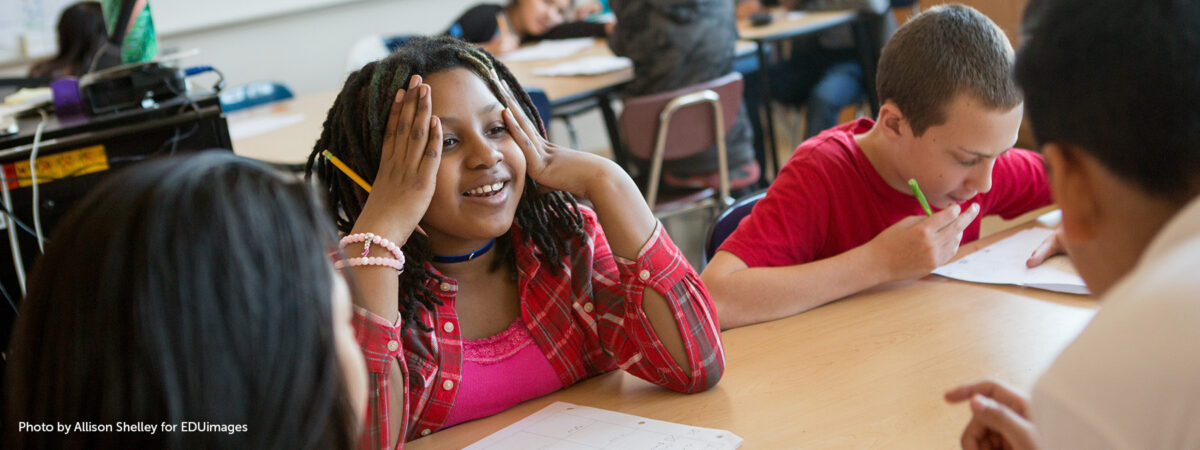
One way educators can help students develop their mathematics literacy is by building their conceptual understanding of the subject. Discussion-based classrooms, where students frequently explain what they think and understand about math, enable students to bridge from what they already know to what they are in the process of learning. However, there are many opportunities for them to become confused. In our research work to support mathematics educators, we’ve explored how an expert teacher supports HSE students to learn challenging mathematics by helping them work through their confusion as they grapple with new concepts.
Ms. Collier is a Black teacher who grew up on the south side of Chicago and attended Chicago Public Schools. As an educator for more than 16 years, Ms. Collier had an explicit goal to educate and empower Black students. She explains, “I want to teach Black students. Very specifically, I want to teach people who look like me.” Her purpose is to be “a positive representation of a Black person teaching math,” so that her students can “see people that look like them educated and being able to educate them.”
Ms. Collier realizes that her students often get confused in math class, and she works very hard to support them in understanding ambitious and complex mathematics concepts. Below are some key ways Ms. Collier responds to student confusion to support their conceptual understanding.
Below is an excerpt of a discussion between Ms. Collier and her students during a virtual class session. As the class is reviewing a task, a student, Jordan, becomes confused. Ms. Collier responds to his confusion by asking him questions rather than explaining how to find answers.
Ms. C: Okay. So, somebody tell me what you thought the rule was. Share with me your input/output diagram. What’d you come up with? What’d you come up with? Jordan.
Jordan: Oh, the input is 16…And then you uh, uh, uhhhh…
Ms. C: So let’s think about it this way. If you were squaring a number, what would you do? Jordan turns audio off. Turn your mic on. Don’t be tapping out. Turn that microphone on.
Jordan: Multiply by itself.
Ms. C: You would multiply by itself. Right? So, if I’m looking for the opposite, what would I do?
Jordan: Divide by itself?
Ms. C: Divide by itself, right? But I don’t know what itself is technically, right? Like, that’s kinda odd. That’s weird. So, the opposite of a square, you can’t say divide by itself when you don’t know what itself is. Okay? Does anybody know the terminology for the inverse of a square? The inverse of squaring a number is what, Sandra?
Sandra: The square root.
Ms. Collier sequenced her questions to Jordan in such a way that 1) she knew that he could answer each of them, and 2) she knew would lead him toward understanding what she wanted him to learn next. Because she knows both Jordan and his knowledge deeply—as well as the scope of the mathematics she was teaching—Ms. Collier knew which question from her repertoire to ask next. Ms. Collier’s depth of knowledge allowed her to bridge between Jordan’s current and intuitive understanding to new mathematical knowledge.
In her teaching, Ms. Collier regularly taps into her identity, personality, and cultural resources during instruction. We see a glimpse of this through her discussion with Jordan in how she used culturally situated language (“don’t be tapping out”) to discourage Jordan from opting out of the discussion. After Jordan persisted in the discussion, Ms. Collier prompted him to use his understanding of how to square a number to propose a rule for identifying the number whose square is 16. Here, she supports Jordan in recognizing the inverse relationship between the square and square root, without telling him directly. After Jordan responds, “Divide by itself?”, Ms. Collier employs empathy by acknowledging that she too recognizes it sounds “kinda odd,” while affirming Jordan’s reasonable intuition, which supports the class’s collective understanding in making sense of the rule in the problem.
Ms. Collier explained why she has high expectations for her students—such as refusing to allow Jordan to opt out of the problem and pushing students to express their ideas with mathematically precise language:
“It goes back to knowing these kids and knowing what they’re capable of and their maximum potential. I ask my children all the time, why be average when you could be extraordinary? … I want you to go above and beyond because you’re capable of doing so. And if you’re going to go above and beyond in mathematics … you want to use the language that people use because that is the expectation.”
Ms. Collier shows high expectations for her students because she personally believes her students have the capacity to meet them.
Sign up for our newsletter to stay updated on our work about supporting students’ mathematics learning.
Moses, R., & Cobb, C. E. (2002). Radical equations: Civil rights from Mississippi to the Algebra Project. Beacon Press.